

Free Trigonometry Worksheets to Download. Trigonometry Course Outline. Trigonometry - Math. Khanacademy's Channel. MIT's Channel. Lecture - 1 Introduction to Quantum Physics;Heisenberg''s uncertainty principle. MIT 18.01 Single Variable Calculus, Fall 2007. Signal velocity. The signal velocity is the speed at which a wave carries information.
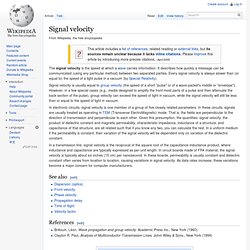
It describes how quickly a message can be communicated (using any particular method) between two separated parties. Momentum. Like velocity, linear momentum is a vector quantity, possessing a direction as well as a magnitude by its own weight Linear momentum is also a conserved quantity, meaning that if a closed system is not affected by external forces, its total linear momentum cannot change.

In classical mechanics, conservation of linear momentum is implied by Newton's laws; but it also holds in special relativity (with a modified formula) and, with appropriate definitions, a (generalized) linear momentum conservation law holds in electrodynamics, quantum mechanics, quantum field theory, and general relativity. Newtonian mechanics[edit] Momentum has a direction as well as magnitude. Quantities that have both a magnitude and a direction are known as vector quantities. Single particle[edit] Kinetic energy. In classical mechanics, the kinetic energy of a non-rotating object of mass m traveling at a speed v is .
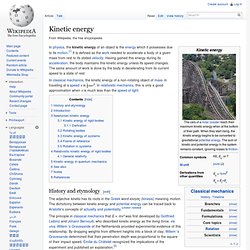
In relativistic mechanics, this is only a good approximation when v is much less than the speed of light. History and etymology[edit] The adjective kinetic has its roots in the Greek word κίνησις (kinesis) meaning motion. The dichotomy between kinetic energy and potential energy can be traced back to Aristotle's concepts of actuality and potentiality. Energy. All of the many forms of energy are convertible to other kinds of energy, and obey the conservation of energy.
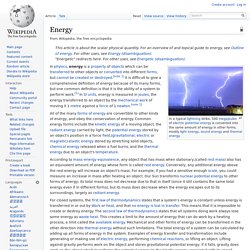
Common energy forms include the kinetic energy of a moving object, the radiant energy carried by light, the potential energy stored by an object's position in a force field,(gravitational, electric or magnetic) elastic energy stored by stretching solid objects, chemical energy released when a fuel burns, and the thermal energy due to an object's temperature.
According to mass–energy equivalence, any object that has mass when stationary,(called rest mass) also has an equivalent amount of energy whose form is called rest energy. Conversely, any additional energy above the rest energy will increase an object's mass. For example, if you had a sensitive enough scale, you could measure an increase in mass after heating an object. Living organisms require available energy to stay alive, such as the energy humans get from food. Forms. Special relativity. Special relativity implies a wide range of consequences, which have been experimentally verified,[2] including length contraction, time dilation, relativistic mass, mass–energy equivalence, a universal speed limit, and relativity of simultaneity.
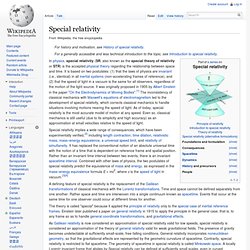
It has replaced the conventional notion of an absolute universal time with the notion of a time that is dependent on reference frame and spatial position. Rather than an invariant time interval between two events, there is an invariant spacetime interval. Combined with other laws of physics, the two postulates of special relativity predict the equivalence of mass and energy, as expressed in the mass–energy equivalence formula E = mc2, where c is the speed of light in vacuum.[3][4] A defining feature of special relativity is the replacement of the Galilean transformations of classical mechanics with the Lorentz transformations. Calculus I - Lecture 1 - A Review of Pre-Calculus.
Matter wave. The de Broglie relations redirect here.
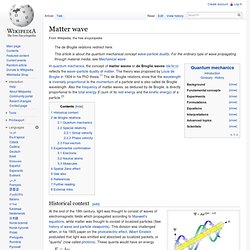
Quantum mechanics. Wavefunctions of the electron in a hydrogen atom at different energy levels.
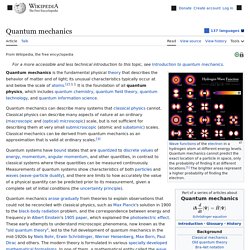
Quantum mechanics cannot predict the exact location of a particle in space, only the probability of finding it at different locations.[1] The brighter areas represent a higher probability of finding the electron. Quantum mechanics (QM; also known as quantum physics, quantum theory, the wave mechanical model, or matrix mechanics), including quantum field theory, is a fundamental theory in physics which describes nature at the smallest scales of atoms and subatomic particles.[2] Quantum mechanics gradually arose from theories to explain observations which could not be reconciled with classical physics, such as Max Planck's solution in 1900 to the black-body radiation problem, and from the correspondence between energy and frequency in Albert Einstein's 1905 paper which explained the photoelectric effect.
History[edit] Modulation. In electronics and telecommunications, modulation is the process of varying one or more properties of a periodic waveform, called the carrier signal (high frequency signal), with a modulating signal that typically contains information to be transmitted.
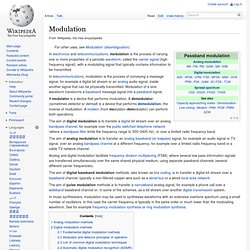
In telecommunications, modulation is the process of conveying a message signal, for example a digital bit stream or an analog audio signal, inside another signal that can be physically transmitted. Modulation of a sine waveform transforms a baseband message signal into a passband signal. A modulator is a device that performs modulation. A demodulator (sometimes detector or demod) is a device that performs demodulation, the inverse of modulation. A modem (from modulator–demodulator) can perform both operations. Group velocity. For example, imagine what happens if a stone is thrown into the middle of a very still pond.

When the stone hits the surface of the water, a circular pattern of waves appears. It soon turns into a circular ring of waves with a quiescent center. Refractive index. Dispersion (optics) In optics, dispersion is the phenomenon in which the phase velocity of a wave depends on its frequency,[1] or equivalently when the group velocity depends on the frequency.
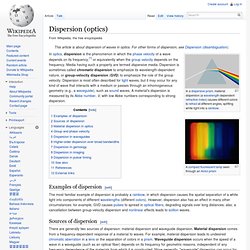
Media having such a property are termed dispersive media. Dispersion is sometimes called chromatic dispersion to emphasize its wavelength-dependent nature, or group-velocity dispersion (GVD) to emphasize the role of the group velocity. Dispersion is most often described for light waves, but it may occur for any kind of wave that interacts with a medium or passes through an inhomogeneous geometry (e.g., a waveguide), such as sound waves. A material's dispersion is measured by its Abbe number, V, with low Abbe numbers corresponding to strong dispersion. The variation of refractive index vs. vacuum wavelength for various glasses. Faster-than-light. Faster-than-light (also superluminal or FTL) communications and travel refer to the propagation of information or matter faster than the speed of light. Under the special theory of relativity, a particle (that has rest mass) with subluminal velocity needs infinite energy to accelerate to the speed of light, although special relativity does not forbid the existence of particles that travel faster than light at all times (tachyons).
On the other hand, what some physicists refer to as "apparent" or "effective" FTL[1][2][3][4] depends on the hypothesis that unusually distorted regions of spacetime might permit matter to reach distant locations in less time than light could in normal or undistorted spacetime. Although according to current theories matter is still required to travel subluminally with respect to the locally distorted spacetime region, apparent FTL is not excluded by general relativity. FTL travel of non-information[edit] Daily sky motion[edit] Electromagnetic radiation. The electromagnetic waves that compose electromagnetic radiation can be imagined as a self-propagating transverse oscillating wave of electric and magnetic fields. This diagram shows a plane linearly polarized EMR wave propagating from left to right. The electric field is in a vertical plane and the magnetic field in a horizontal plane.
Speed of light. Wave opposite-group-phase-velocity.gif - Wikipedia, the free encyclopedia. Lambda. Lambda (uppercase Λ, lowercase λ; Greek: Λάμ(β)δα lam(b)da) is the 11th letter of the Greek alphabet. In the system of Greek numerals lambda has a value of 30. Lambda is related to the Phoenician letter Lamed In early Greek alphabets, the shape and orientation of lambda varied.[2] Most variants consisted of two straight strokes, one longer than the other, connected at their ends.
The angle might be in the upper-left, lower-left ("Western" alphabets), or top ("Eastern" alphabets). Other variants had a vertical line with a horizontal or sloped stroke running to the right. The HTML 4 character entity references for the Greek capital and small letter lambda are "Λ" and "λ", respectively.[3] The Unicode number for lambda is 03BB. Wavelength. Assuming a sinusoidal wave moving at a fixed wave speed, wavelength is inversely proportional to frequency of the wave: waves with higher frequencies have shorter wavelengths, and lower frequencies have longer wavelengths.[6] Wavelength depends on the medium (for example, vacuum, air, or water) that a wave travels through. Examples of wave-like phenomena are sound waves, light, and water waves. Phase velocity. Transducer. Sound. International System of Units. For a topical guide to this subject, see Outline of the metric system. Physics.
Heinrich Hertz. Wave. Oscillation. Oscillation is the repetitive variation in time of some measure about a central value (often a point of equilibrium) or between two or more different states. The term 'vibration' is precisely used to describe mechanical oscillation but used as a synonym of 'oscillation' too. Familiar examples include a swinging pendulum and alternating current power. Oscillations occur not only in mechanical systems but also in dynamic systems in virtually every area of science: for example the beating human heart, business cycles in economics, predator-prey population cycles in ecology, geothermal geysers in geology, vibrating strings in musical instruments, periodic firing of nerve cells in the brain, and the periodic swelling of Cepheid variable stars in astronomy.
Simple harmonic oscillator[edit] Damped and driven oscillations[edit] All real-world oscillator systems are thermodynamically irreversible. Some systems can be excited by energy transfer from the environment. Hertz. Frequency. Three cyclically flashing lights, from lowest frequency (top) to highest frequency (bottom). f is the frequency in hertz (Hz), meaning the number of cycles per second. T is the period in seconds (s), meaning the number of seconds per cycle. T and f are reciprocals. In some fields, especially where frequency-domain analysis is used, the concept of frequency is applied only to sinusoidal phenomena, since in linear systems more complex periodic and nonperiodic phonomena are most easily analyzed in terms of sums of sinusoids of different frequencies.
Definitions and units[edit] Sinusoidal waves of various frequencies; the bottom waves have higher frequencies than those above. For counts per unit of time, the SI unit for frequency is hertz (Hz), named after the German physicist Heinrich Hertz; 1 Hz means that an event repeats once per second. A traditional unit of measure used with rotating mechanical devices is revolutions per minute, abbreviated r/min or rpm. 60 r/min equals one hertz.[1] Photons - Google Search. Light Frequencies" Photon - What is a photon? Photon.
The Elegant Universe. Home Page. M Theory Part 1. String Theory, M-theory, Parallel Worlds Pt. 1. M-theory, the theory formerly known as Strings. M-theory. The Official String Theory Web Site. Science v's God : Its The Collapse Of Physics As We Know it.